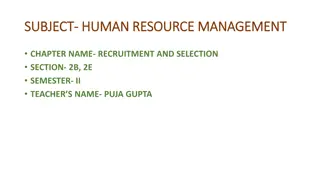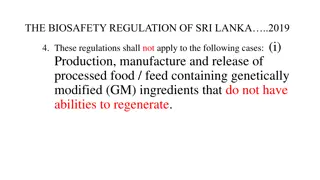Understanding One-Stop Operator Selection Regulations and Roles
The One-Stop Operator plays a crucial role in managing and coordinating services within the One-Stop System in compliance with WIOA regulations. This includes ensuring integrated service delivery, establishing Memorandums of Understanding with partners, and supporting infrastructure costs. Eligible entities for the Operator role are outlined in WIOA guidelines, with the application process consisting of multiple sections designed to assess organizational capabilities. Detailed scoring templates are available for applicants to understand the review process.
Download Presentation

Please find below an Image/Link to download the presentation.
The content on the website is provided AS IS for your information and personal use only. It may not be sold, licensed, or shared on other websites without obtaining consent from the author. Download presentation by click this link. If you encounter any issues during the download, it is possible that the publisher has removed the file from their server.
E N D
Presentation Transcript
One-Stop Operator Selection
ONE-STOP OPERATOR SELECTION REGULATIONS WIOA Joint Rule Volume 1 678: Description of the One-Stop System Under Title I of the Workforce Innovation and Opportunity Act WIOA 121: Establishment of One-Stop Delivery Systems ARM 2.5.603: Small Purchases or Limited Solicitations of Supplies and Services
ONE-STOP SYSTEM The Workforce Innovation and Opportunity Act (WIOA) aims to improve workforce systems by providing better career options for job seekers through an integrated system that connects talent to businesses. The One-Stop system plays a critical role in enhancing and streamlining operations to integrate systems and partners into an improved system that better serves job seekers and businesses.
ONE-STOP OPERATOR ROLE The One-Stop Operator is responsible for managing and coordinating the services provided through the One-Stop System and ensuring that providers and partners are delivering services in an integrated way in compliance with WIOA. The One-Stop Operator is responsible for ensuring that appropriate Memorandums of Understanding (MOUs) are in place for all partners outlining roles and responsibilities to the One-Stop System. The One-Stop Operator is responsible for working with the board to ensure that all partners are helping to support the infrastructure costs of the One-Stop System.
WHO CAN BE A ONE-STOP OPERATOR WIOA 121(d)(2)(B) outlines the entities that are eligible to serve as the One-Stop Operator. shall be an entity (public, private, or nonprofit), or consortium of entities (including a consortium of entities that, at a minimum, includes 3 or more of the one-stop partners described in subsection (b)(1)), of demonstrated effectiveness. . .
ONE-STOP OPERATOR APPLICATION Each section in the One-Stop Operator application is designed to give the reviewer a full picture of the organization s ability to manage the One-Stop System. Part I and Part II are in a fillable-form format; however, if the applicant needs additional space, the applicant can submit a supplement. Part III, IV, and V are in Excel and are submitted in addition to the application.
ONE-STOP OPERATOR SCORING A copy of the One-Stop Operator scoring template is available for applicants to review to ensure they know how the review committee is scoring applications.























